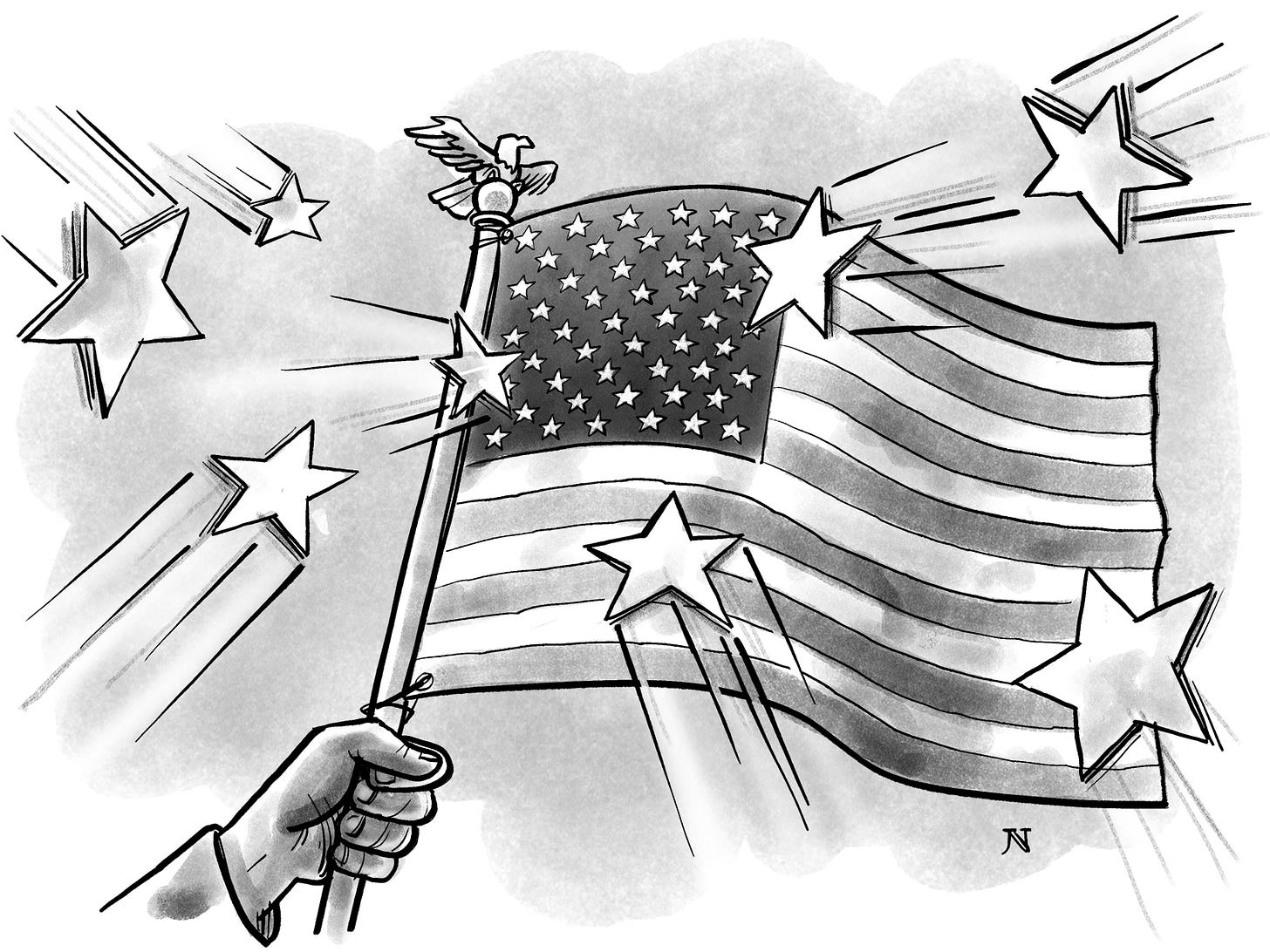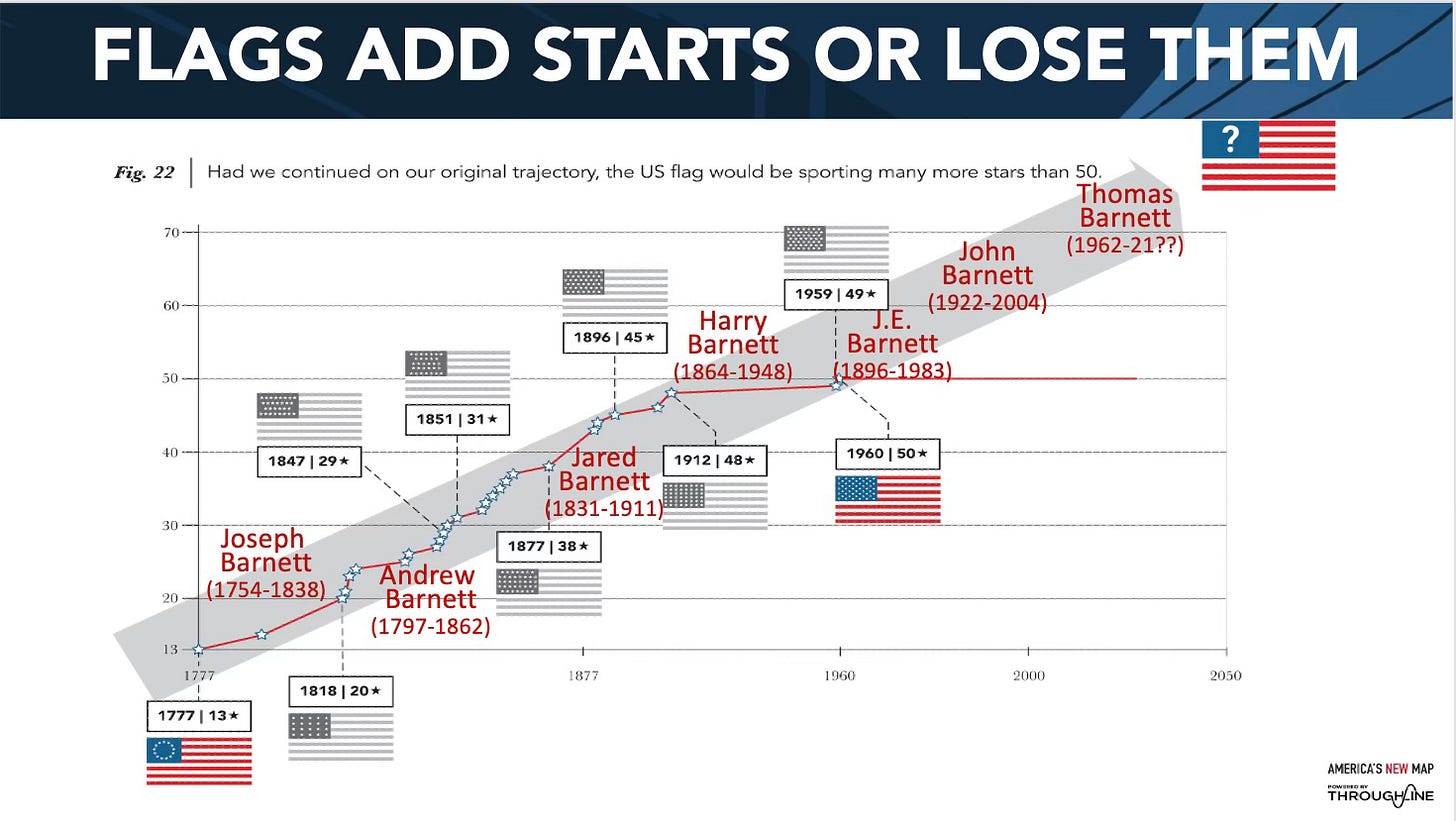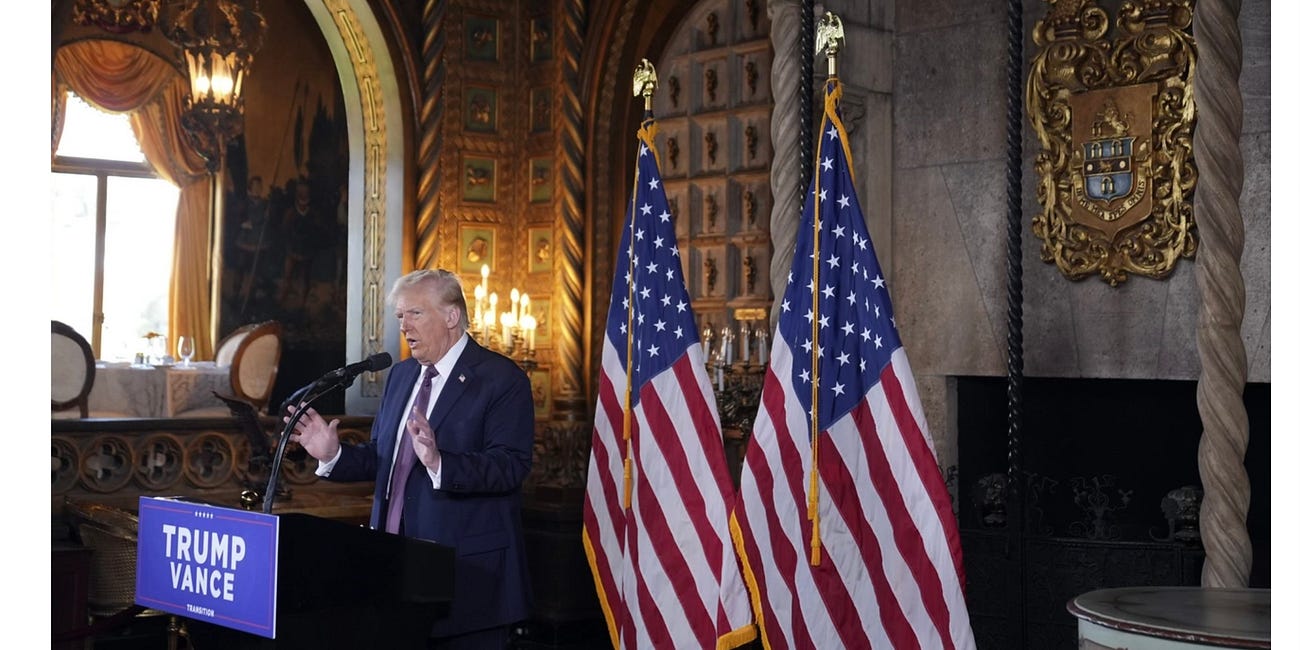I know, I know … with Trump acting so belligerently in all directions but especially across our hemisphere, this post will seem fantastic.
But remember: don’t confuse the friction for the force. Today’s friction is white hot, but the logic of the tectonic forces (climate, demographics, consumerism) pushing for North-South integration and aggregation is still there and only building with time.
So, here goes …
There have been numerous versions of Old Glory over the years, typically updated on the first 4th of July following a state accession, the last one occurring in 1960 following Hawaii’s entry the previous August.
This slide, part of one of my lessons in the first Massive Open Online Course (MOOC) I built off the book America’s New Map (now on edX and Coursera), displays the 28 official variants of the US flag. Note, that Betsy Ross’s famous circular-star pattern does not appear on this list. It was the equivalent of fan fiction — sort of fan stitching (fan stitch).
All of these variants remain legit for display — sort of like throw-back uniforms in the NFL.
Details just got added over the decades, as America went from 13 original members to its current 50.
It was entirely normal for Americans, for the first 17 decades of our nation’s existence, to see a new star added, on average, just over every three years.
My favorite family example is Jared Barnett, my Great Great Grandfather, who was born (1831) under a US flag with 24 stars and died under one with 46 — a gain of 22 stars in one lifetime!
Here’s a quasi-animated timeline presentation on Old Glory:
You can say, But that’s a Before Times reality that cannot be replicated today!
But, let’s look at just my life (born 1962) if I am still living in Europe instead of migrating to the US: I would have been born under a proto-EU “flag” (European Economic Community) uniting a mere six states. Today, my flag (if accurate) would display 27 stars — an expansion of 21 states over 62 years (or roughly one new star every … wait for it … three years!
And yes, the EU has toyed with the idea of different flags, sticking with the conservative ring of 12 stars.
If you really want to pig out on flags over the years, try this 17-minute video:
Sheldon Cooper would be going nuts right now.
Getting to my book:
Count up the fully displayed stars and you get 153 stars.
Crazy, right?
But here was the thinking: If I’m going to project a United States of the Americas, why not calculate the logical number of stars that would generate?
My Politico Magazine "Big Idea" essay
An Expert in Grand Strategy Thinks Trump Is on to Something
Do you want a future in which Canada defects to the EU, Russia rules the Arctic and China runs Latin America? That’s the default outcome of non-action.
Recall my Politico piece where I argued the following regarding the notion of Canada as the 51st state:
But let’s also get more real in our thinking and the terms we offer. Justin Trudeau is right when he says Canada will never become America’s 51st state, but what if it became America’s 51st-through-59th-states? Would that be enough political power and standing for Canadians to choose over admission into the EU? Say, 18 Senate seats and more congressional districts than California’s 52 seats?
So, how does one get to such calculations?
Let me spin some ways:
Start with 50 US states
But let’s add in DC, PR, and a collection of Pacific territories for 53.
An expanded current-US is thus 53 members strong
Now, let’s consider Canada’s ten provinces: because the total economy is so big, I say, we let in each of the ten as separate states (average population of 4m matches our median state of Kentucky).
I say we also let in the three territories (Yukon, Northwest Territories, and Nunavut) as separate states, because, over time, that’s where we’ll see rapid populating and development in the very north of Canada (plan ahead for growth!).
So, Canada gets 13 stars, raising USAs to 66 stars
Now, let’s keep it simple when looking at the 35 total sovereign states of the Americas, which doesn’t include Greenland (subordinate to Denmark), so 36 total entities, minus the already accounted-for US and Canada, leaving us with 34 to go.
Of those 34, 19 pass the Wyoming test of having enough population to break into America’s current top-50 states by size (Wyoming is the smallest US state by population at 588k) but are not bigger than our current biggest state of California (39m). Also, none of them are such big economies that a singular-state designation wouldn’t seem logical and fair.
Those 19 states, then, we just let in as singular states/stars:
Peru
Venezuela
Guatemala
Ecuador
Cuba
Haiti
Bolivia
Dominican Republic
Honduras
Paraguay
El Salvador
Nicaragua
Costa Rica
Panama
Uruguay
Jamaica
Trinidad and Tobago
Guyana
Suriname
So, if we count up the smaller Americas states that qualify under the Wyoming principle, we add 19 to 66 for 85 states/stars
That leaves us with 15 states to consider.
Nine of them fail the Wyoming size test:
Antigua and Barbuda (~94,000)
Bahamas (~400,000)
Barbados (~281,000)
Belize (~444,000)
Dominica (~72,000)
Grenada (~112,000)
Saint Kitts and Nevis (~47,000)
Saint Lucia (~185,000)
Saint Vincent and the Grenadines.
I say we bundle them up into a single US-kluged Caribbean Island state.
Now we’re up to 86 stars, with six entities to go
Let’s add in Greenland as a singular state because of its sheer geographic size and despite having only 56k population, which is bound to grow in this climate-changed world of our — again, plan for growth!
87 stars, with five entities to go
Those five are:
Mexico ($1.8T nominal GDP; 138M population)
Brazil ($2.3T; 222M)
Argentina ($600B; 47M)
Colombia ($372B; 53M)
Chile ($300B; 20M)
Why not just give each one state/star? Because they’re either too big economically (GDP above/near the US state median of $333B [Oregon]) or too big population-wise for that to be/seem fair.
So, let’s consider them by their current number of internal states/provinces, because the simplest/most respectful way of admitting them is to accept their current political structure:
Mexico: 31 states plus 1 federal district (Mexico City), totaling 32 federative entities.
Brazil: 26 states plus 1 federal district, totaling 27 federative units.
Colombia: 32 departments.
Chile: 16 regions.
Argentina: 23 provinces plus 1 autonomous city (Buenos Aires), totaling 24 federative units.
If we add all those states in like that, we’re adding a total of 131 entities, which would bring our grand total up to 218 stars/states.
But these seem, in certain instances, like far too many given overall population and economic size relative to the US and Canada — our two big North American anchors.
Let’s start with Brazil, because 27 states there seems fair enough at roughly 8m per entity (bit over US state average of 6.8m).
Brazil’s 27 states gets us up to 114 stars/states
Colombia’s 32 is far too much. Averaging 1.7m/entity, I say we ratchet that down to three states, each with a decent sized GDP that would rank in the top 40 of current US states.
Same basic argument for Argentina gets us 3 more.
Same approach with Chile warrants 2 more.
Adding a total of 8 for Argentina, Colombia, and Chile gets us up to 122 stars/states
Leaving only Mexico. Given its relative economic and population size relative to Brazil, it would seem that 32 stars would be too much to Brazil’s 27.
But, if we did add Mexico’s full total, we’d be up to 155 states — or just two off my book-cover estimate of 153.
If we proportioned Mexico to Brazil, because its current 32 entities would average only about 4m/per in population and Brazil’s economy is about a third larger, then something like 21 would make more sense.
122 stars plus Mexico’s 21 equals 143 stars/states
Which is perfect for signaling that 1990s bit about 143 equating to I LOVE YOU (1 letter, 4 letters, 3 letters).
I rest my case.
How would America’s current 50 states handle this logic?
Hmm, that is a tricky question.
If we take Trump’s logic of one country = one state, then we could only grow the Union by 35 stars/states for a total of 85.
Compare that to our highest-end estimate of 218 stars, and settling on 143 seems pretty much in the middle, right?
America’s 50 states as a percentage would be:
59% of the Union’s membership at 85 states
23% of the Union’s membership at 218 states
35% of the Union’s membership at 143 states.
If we took America’s relative shares of the Americas’ total in GDP and population, we get a 80% share on GDP and a 33% share on population.
Making it more about a fair head count than a straight-up money count, I’m still more attracted to the 143-member-state scenario as being about Goldilocks right.
Point of the exercise?
Nothing more than broad framing the potential long-term hemispheric-integration scenario.
You want Manifest Destiny on a hemispheric scale?
This is how it would logically translate as a mega-union. And what a superpower it would be, with a billion citizens and a superabundance of water, food, energy, and military power.
Believe it or not, this is the kind of stuff I would do as a kid on rainy days.
I am still trying to re-organize the world to my liking.














153? Not 143?
143 - ILY